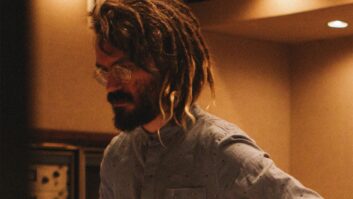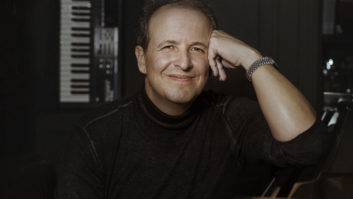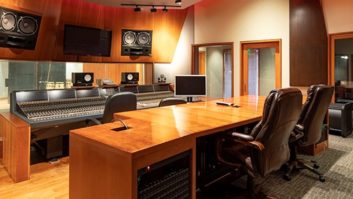
The words “pregnancy” and “birth” are often used to describe the process of creating and finishing a work of art. However, in the case of Folklore, the latest album by Canadian pop star Nelly Furtado, there were more than mere metaphors involved. “We did it in three or four months because we had the greatest deadline of all: We had nature’s deadline — she was giving birth,” says Brian West, who co-produced the record. “We didn’t really know if her voice would give out or how she’d be feeling. Quite amazingly, she was able to sing up to the week that she was actually due to deliver.”
Furtado was only 20 when she finished her 2000 debut album, the multi-Platinum Whoa, Nelly. Co-produced by West and Gerald Eaton (aka Track and Field), the album differentiated Furtado from other young pop divas with an eclectic and international sound: Her songs interlaced elements of Latin, R&B and reggae with dub and hip hop beats and ebullient pop melodies. Whoa, Nelly proved that the young singer/songwriter could get a dance floor moving and craft an inescapable hook. She won a Grammy for her hit single “I’m Like a Bird.”
While pregnancy might seem like a complicating factor, Furtado says it actually helped the recording of her second album go better. “I was way more relaxed about things,” she says. “I think when you’ve got something so huge going on in your life, music is kind of like an afterthought. And that’s what it should be, because music should be fun.”
This new perspective, coupled with the approaching delivery date for her baby, made writing and recording Folklore a much faster and more spontaneous process than on her first record. “The first album, we would spend probably five or six days producing a track,” Furtado says. “We wouldn’t even touch vocals. By the time I got to my vocals, you kind of lose the inspiration of the song a little, so it made it very challenging to do the vocals. They would sometimes take three days to get the right mood, and sometimes the melody would have to change because the music had gone so far ahead and didn’t suit it anymore. We didn’t want that for Folklore — we did the opposite. We really pushed each other. We went, ‘Okay, let’s throw out all the ways we’ve been working and just kind of do something new.’ Some days we’d record a song the same day we wrote it.”
Unusual for a young pop star, Furtado co-produced both of her records. “I’ve always liked producing vocals,” she says. “I’ve always known what kind of harmonies I want to hear. Arrangements, things like that — that stuff interests me. I grew up playing a lot of instruments. I grew up playing the trombone; I played jazz band, concert band, marching band. As a young kid, my first instrument was a ukulele. I remember even at that age I would listen to an old Portuguese song on tape and transpose it onto my ukulele so I could perform it live. So I always liked the idea of reinterpreting music.”
Reinterpretation was a central idea behind Folklore. It began when Furtado says she “got obsessed with this idea of folk. What is folk? The simplicity of that idealistic folk music of the ’60s, a sort of lyrical weight. But I also wanted to do an update: How do I translate folk to me in the year 2004? I grew up with a lot of folk music — Portuguese folk music in church songs — and I started thinking, ‘Wow, I’m technically a world pop artist or international pop artist, and every country has their own folk music, every place has their own version.’ So I thought, ‘Well, I could definitely do my own update.’”
Furtado discussed the idea with Eaton and West, and they began to actualize it as they composed the album together in the studio. Their first track started simply as a breakbeat wedded to a banjo. “We talked about combining something hip hop-y and folk-y; there’s nothing more folkloric than a banjo,” says Eaton. “The instrument itself has so much history. It’s really one of the most uplifting sounds.” The experiment evolved into the album’s opening song, “One Trick Pony.” “We kept coming back to that first song as the balance that we wanted to strike between old and new, between folk and hip hop, between fresh and traditional,” Eaton says.
Folklore combines an impressive range of traditional instruments with Furtado’s and Track and Field’s signature hip hop and dance rhythms: Besides the banjo, its songs feature a mandolin, harp, Portuguese ukulele, tabla, harmonium and church organ. “A lot of times, we just want to hear something interesting,” says West. “What would be a crazy idea to combine with this? If it makes us laugh, then it’s something we want to try to accomplish.”
Several well-known artists lent their talents to the album. The fascination with banjos led to a guest appearance by Béla Fleck on the anthemic “Força.” Brazilian superstar Caetano Veloso added his vocal to “Island of Wonder.” And the Kronos Quartet supplied a string arrangement for “One Trick Pony” via the Internet. “They did it up at Skywalker Ranch outside of San Francisco. We literally posted our song on a Website and they downloaded it, added their stuff and sent it back to us,” West says.
One of the high points of making the album was the closing track, “Childhood Dreams,” a 3/4-time ballad that was recorded in the First Congregational Church of Los Angeles using the church’s giant organ. “I think it’s the biggest organ in North America. It’s this massive instrument with 64-foot-long pipes,” recalls West. “Luckily, this is one of the cases where Brad Haehnel, the guy who mixes our stuff, is pretty adept at doing church recordings because he has a really big background in film music and that sort of thing; he’s recorded organs in churches all over the world.” Haehnel miked the organ with a pair of M-50s.
Although the creative team was the same, the process of writing Folklore was significantly different than on Whoa, Nelly. “I wrote most of the songs on my guitar for the last album, the more straight-ahead stuff like ‘I’m Like a Bird,’ and ‘Turn off the Light,’” Furtado explains. On her new album, almost everything was written collaboratively with Eaton and West in the studio. Songs often evolved from jam sessions where the producers played guitar and harmonium while Furtado improvised melodies. “I found that when someone else played the music and I would just have to be responsible for the melody and lyrics, I felt really free and I felt like I was growing,” she says. “It set me free to dig deeper into the intent of the song and the emotion of the song.”
Furtado’s improvisational style reached an impressive extreme on “Força,” which she wrote during a publicity shoot for her record label. “She had this whole camera crew come in and interview us,” West recalls. “And she just decided to start singing to give them some stuff — to get some footage of her in the vocal booth singing. We just started to roll tape and she started singing, and basically [she] wrote the entire song within the first two takes while the camera crew was filming. It was pretty insane.”
To accommodate Furtado’s pregnancy, the recording took place at two locations: The Gymnasium, Track and Field’s laid-back, loft-style studio near the beach in Santa Monica, Calif., and MetalWorks, located near Furtado’s home in Toronto, which they used when the singer was no longer able to fly to Los Angeles. Most of the album was recorded onto a Titanium PowerBook equipped with Pro Tools, using Neve 1073 mic pre’s for the inputs.
West notes that the pregnancy had an effect on Furtado’s vocals: “She definitely was singing lower and more from her diaphragm. And we also discovered this mic on this record: We used a Sennheiser 451, which is usually a tom mic or quite often it’s used on horns. We did a mic shoot-out with Telefunken and Sony, and it ended up that this mic just sounded really good. It had a nice little notch of compression right around where the real aggressive tones in her voice are, and it just fit her like a shoe. So she was really inspired; I think it was the first time that she was able to really sing and belt and go anywhere without worrying about blowing up a microphone.”
Engineer Haehnel mixed Folklore on an SSL J 9000 board at MetalWorks during the final month of recording and found the mixing fairly straightforward. “[The vocals] were pretty much done by the time I got them, so that was actually an easier part,” he explains. “We spent a lot of time on each vocal — making sure that we had the right path, the right sound — by the time that I got it. That was one major timesaver that we did institute early on.”
After the toil of touring to promote her first album, Furtado found that recording Folklore was a rejuvenating experience. “It’s funny,” she says. “I finished this album a week before I gave birth to my daughter, and I remember sitting on a chair and listening to the final mix of the album for the first time, sitting with my CD player. After I finished listening to it, I just felt really excited about music again. I remembered what I liked about making music, which I think I totally forgot after I got off the road from the first one.”







